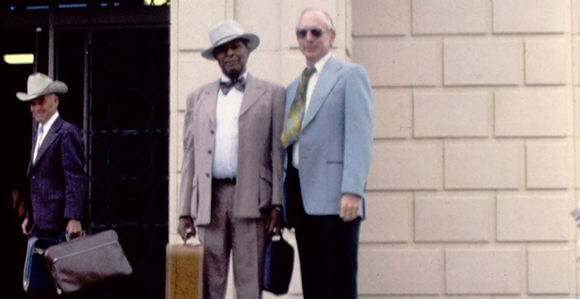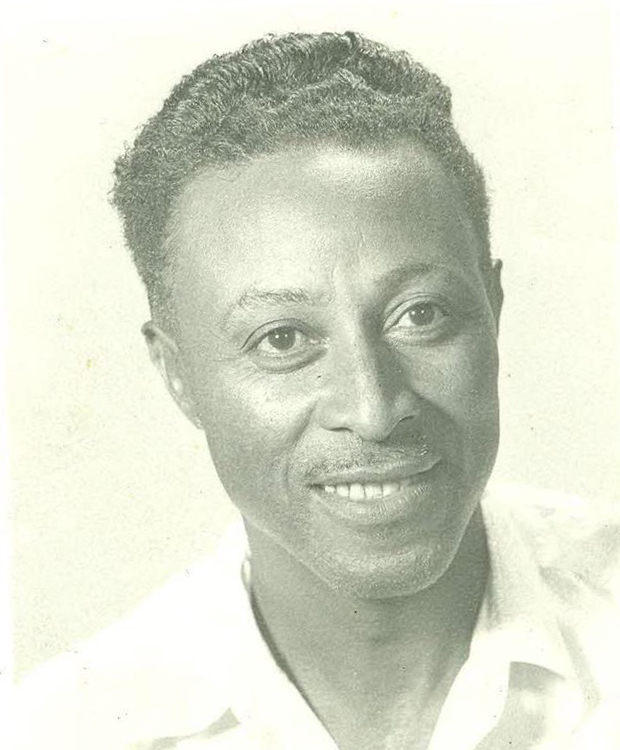While Waiting 25 Years to Receive the Priesthood, Harry Bailey Jr. Changed a Community
Contributed By Aubrey Eyre, Church News contributor

From left: Eldon Smith, who baptized Harry Bailey Jr. in 1953, and Harry with Irval Mortensen.
Article Highlights
- Despite his many challenges, Harry Bailey Jr. was an example of a true minister and follower of Christ.
“He was a good listener. He treated you like you were somebody because to him you were somebody.” —Johanna Brutinell
Related Links
When Irval Mortensen, a Church member from Safford, Arizona, tuned in to watch the “Be One” celebration in June, his thoughts turned immediately to a figure from his past—someone he described as an “unforgettable character,” and someone he hoped would be remembered, even as his own memory fades.
As a teenage boy growing up in the Gila River Valley of eastern Arizona, Mortensen spent much of his free time about 10 miles west of his house in the rural town of Central. There, just west of Highway 70 and the railroad tracks that run parallel to the road, stood a small shack-like home on the edge of a cotton field. It was a small and humble structure, likely meant to serve as a semi-permanent residence for a farmer to house seasonal workers. It had no indoor plumbing and no water. Water had to be carried in buckets from across the railroad tracks and highway. With just a small kitchen space, a small bedroom, and a small living room area, the house was hardly considered an ideal place for youth of the area to hang out in their free time, but despite its lack of modern comforts, the house and its resident served as a refuge for many youth in the community.
The full-time resident of the small shack was a man named Harry Bailey Jr., and in the year 1953, when he was baptized, Bailey was one of the only African American members of the Church in the Safford area.
A different kind of family
“Harry grew up poor and lived poor,” Mortensen said.
When Mortensen first met Bailey in 1952, Bailey was at least 54 years old, while Mortensen was just entering his final year of high school.
Church records, social security records, and even Bailey’s obituary contradict Bailey’s birthdate, Mortensen explained, but as far as he has been able to research, Bailey was born sometime between 1898 and 1909 in the state of Georgia.
“Harry told us of growing up on the Bailey Plantation in Georgia,” Mortensen said. “From his stories, I believe his grandmother was a slave, at least in her youth, and the living he described was pretty much like a slave camp, … hence why he had the last name of Bailey.”
Mortensen never knew how or why Bailey ended up in the Gila Valley, but that part didn’t matter much to him in his teenage years. To him, Bailey was a staple of the community and a great friend.
Bailey was single, had never been married, and had no children of his own, yet photos of youths, mostly young men from the Safford and Central areas who were serving missions or who had gone into military service, were displayed proudly on a long table adorned with handmade doilies in his home. As Mortensen and his younger sister, Lafaunda Curtis, explained in a recent interview with the Church News, these were Bailey’s family, “his boys.”
Fond memories
“Harry worked whatever jobs he could find and always had some work,” Mortensen said. “Farm labor, picking cotton by hand, roofing houses, etc. And he seemed to know everyone—the farmers, politicians, Church leaders, and the African American community.”
While Bailey had no formal education, he had learned to play the piano and organ and could read and write. In the Gila Valley, Bailey spent much of his time with the local Relief Society sisters, learning to knit, crochet, and cook.
“He made delicious bread,” Mortensen recalled. “And he was always making something by crochet, … but by the time he finished it, it was quite dirty.”
Despite his many domestic skills, Bailey wasn’t much of a housekeeper, and, with a small iron pot-belly stove as his only heat source, smoke and ash often covered the surfaces in his small home. Bailey was always making things for others. “Before he would give his crocheted items away, he would wash them to change the color from ash grey to white,” Mortensen said.
Johanna Brutinell and her husband, Mautice, were among the youth of the valley who often sought refuge at Bailey’s home, and when they were married, Bailey attended their reception and gave them three pot holders that he had crocheted himself. “We still have one,” Johanna Brutinell said.
Through their 62 years of marriage, Bailey has remained an important figure in their minds.
“I remember from the first time walking into Harry’s shack … he just had the ability to make you feel like the only person in the room,” Johanna Brutinell said. Even if there were 15 people around, he made each individual feel special, she recalled.
Kindness first
On Friday and Saturday nights in the Gila Valley, the youth who were looking for something to do would often end up at Bailey’s house.
“We’d go there just to talk and listen to Harry’s stories and to plan mischief,” Mortensen said, noting that many of the adults in the area never seemed to understand why the youth chose to spend their time there. “Prejudice against African Americans was very common, and Harry expected and accepted it.”
But while Bailey was aware of the prejudices against his skin, the youth who so frequently sought his company seemed to not fully understand it.
Johanna Brutinell said that as teenagers, they didn’t pay much attention to how other people treated Bailey, or to the issues of race in their community. To them, “Harry was just a good friend, someone we could go and talk to any time,” Johanna Brutinell said. “It didn’t really occur to us that he was black. He was just Harry.”
As Mortensen recalled, he didn’t think much about racism. When attending the movies with his young friends, Bailey was required to sit in the balcony section, due to the color of his skin; and at restaurants, Bailey was required to go to the back door to order his food, Mortensen recalled. And although it bothered him when Bailey was treated differently, he said that as a teenager, he didn’t feel there was anything he could do to change that.
But despite the prejudice shown to him, Bailey treated all alike and all kindly.
A Christlike example
For Mortensen, Johanna Brutinell, and Curtis, Bailey stands out in their minds as a perfect example of what it truly means to minister and to be a ministering brother.
“He was a good listener,” Brutinell said. “He treated you like you were somebody because to him you were somebody.”
Bailey was always there to listen to their stories and their plans for the future and to counsel with the youth, Mortensen explained. Bailey was always understanding, and he would help whenever he perceived a need.
“He didn’t want anything. He never did,” Brutinell said. “He would just give of his time. Youth would go see him with their problems, especially the problems they felt they couldn’t go to their parents with.”
One time, when a student from a nearby community college ran out of funds to stay in his college accommodations, Harry made a place for him by giving the kid his own bed and sleeping on the couch himself, Mortensen recalled.
“He had very little, so he ministered with his time,” Curtis said. “He would’ve given anything anyone asked of him.”
And although Bailey never had a lot of close family or connections, he had an impact on everyone around him. “He was an example of kindness and the ability to love without judgment,” Curtis said. “He was a colorful staple in the valley. Just a truly loved character.”
Waiting for change
Bailey’s good character and the way he affected his community is part of why Mortensen and Curtis felt so strongly about wanting to share the story of their dear friend following the “Be One” event in June.
Curtis said that during the event, Bailey was the only person she could think about, particularly remembering his tolerance for so many things and his perseverance through so many difficulties in life.
Among the difficulties Bailey faced, like many black members of the Church, was difficulty with understanding his role prior to the 1978 revelation on the priesthood.
“He told me once that if he could strip off his skin to hold the priesthood, he would,” Johanna Brutinell said.
Throughout the years, Bailey was inconsistent with his activity in the Church. At times, he would only attend Relief Society meetings, where he learned a great deal from the sisters. In the late ’70s, due to health problems, he attended church very infrequently. But around that time, many years after Mortensen had returned from his mission and after Bailey had been forced to move from his small condemned shack near the railroad tracks, Mortensen became Bailey’s bishop.
In June of 1978, while at work on Main Street in downtown Safford, Mortensen received a call from his wife, who had just received word that all worthy men could be ordained with the priesthood, regardless of their skin color.
“I left my office and went to see Harry with the news,” Mortensen said. “He was in his home, which needed some cleaning, and pictures of ‘his boys’ were still on display.”
When Mortensen explained the news to Bailey and reviewed the process for being ordained an elder and entering the temple, Bailey told his young bishop that he had been waiting for this day for a long time. He even had a set of pressed temple clothes ready to go.
On November 15, 1978, Harry Bailey Jr. was endowed in the Mesa Arizona Temple. It was a day he had waited 25 years for, since the day he had joined the Church.
A remarkable character
In May of 2010, more than 20 years after Bailey died, on a plot of land visible from where Bailey’s old shack-like house had once stood, the Gila Valley Arizona Temple was dedicated by President Thomas S. Monson.
For those who remember Bailey and the impact he had on the community, the temple there is a reminder of the faith and kindness of a remarkable character with a selfless spirit.
“Harry always had a twinkle in his eye,” Curtis said. “He had a great sense of humor and he was a proper gentleman, just always a very kind man.”
As a true minister and an example of what it means to “love thy neighbor as thyself,” Bailey taught Mortensen and Curtis many things over the years, for which they expressed their gratitude, and with their memories starting to fade, they expressed the hope that others would learn from Bailey as well.
“We can’t let his memory die,” Curtis said. “He deserves to be remembered.”

Portrait of Harry Bailey Jr. Photo courtesy of Irval Mortensen.
